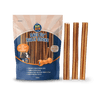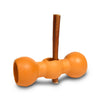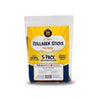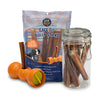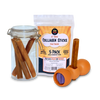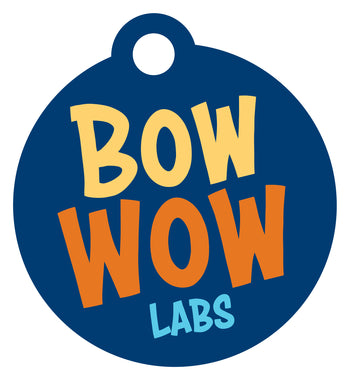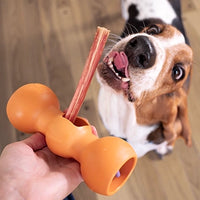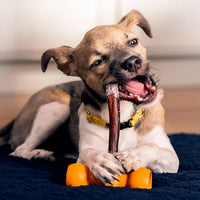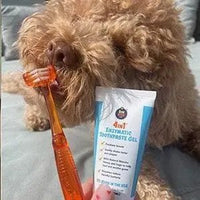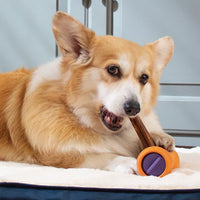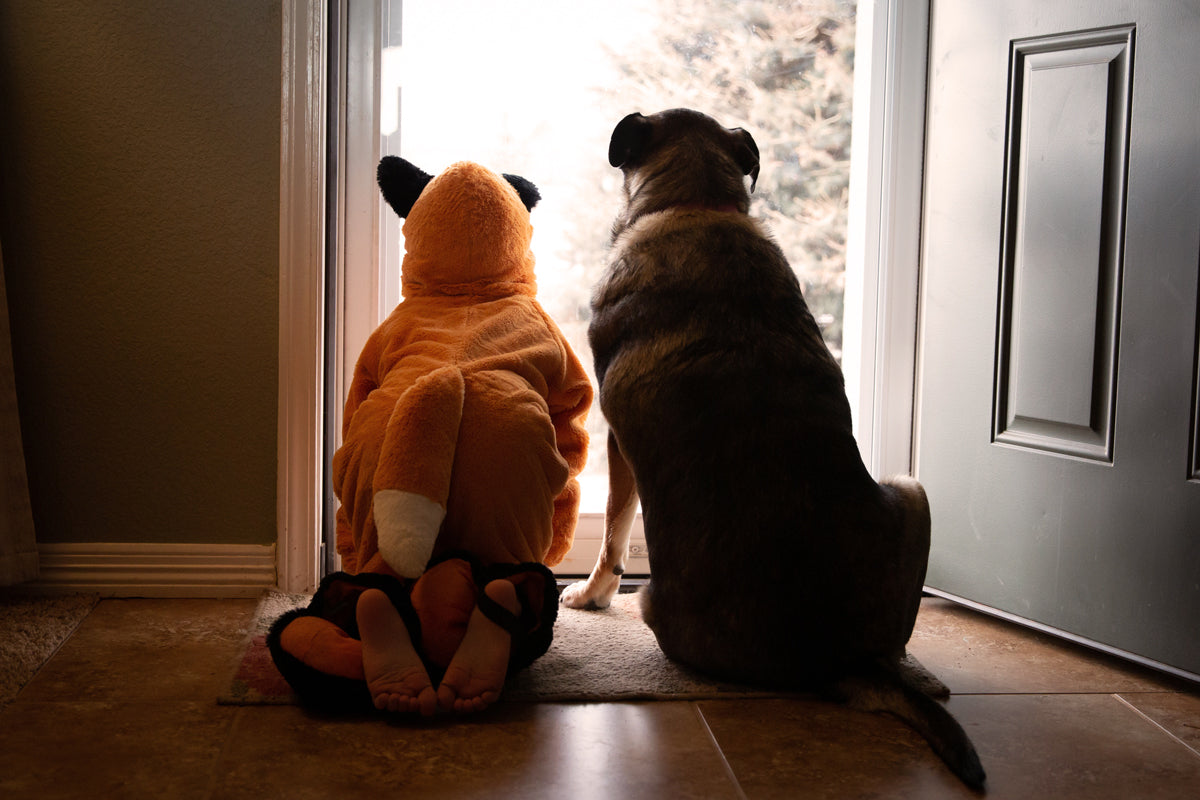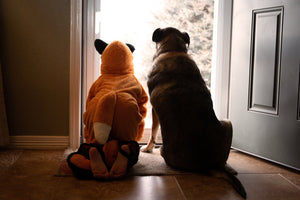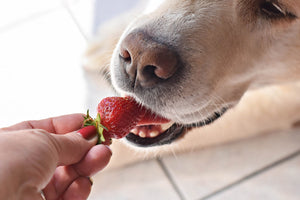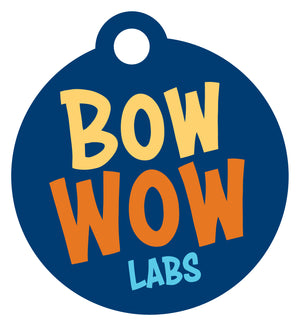Halloween may be full of fun for us humans—with costumes, candy and spooky décor to get us in the holiday spirit—but for dogs, Halloween can be a night of sensory overload. From unexpected noises, ghoulish costumes and tempting human sweets, the festivities can introduce a range of hidden hazards. But, with just a little planning, you can help your dog enjoy a calm, safe and happy Halloween.
Here's all you need to know to keep your pup safe this All Hallows’ Eve:
1. Treats Are for Humans Only
Those bowls of candy might look harmless, but they are one of the biggest Halloween hazards for dogs, especially if you're handing out dark chocolate or sugar-free options. Chocolate contains theobromine, a stimulant that dogs can’t easily process and can cause poisoning even in small amounts. Theobromine is more concentrated in darker chocolate, but milk chocolate can still cause problems. Even more dangerous is xylitol, a sugar substitute often found in sugar-free candies and gum, which can cause life-threatening drops in blood sugar.
Keep all sweets and wrappers well out of reach, preferably in closed containers and above counter height (especially if you live with a talented counter-surfer).
If you suspect your dog has eaten chocolate or xylitol, contact your veterinarian, 24-hour emergency vet or the Pet Poison Helpline immediately.
2. Make a Safe, Quiet Retreat
Strange costumes, constant doorbell rings and excited trick-or-treaters can trigger anxiety in all dogs, but especially in those with known issues. An easy way to help set your dog up for success is to set up a “safe zone” inside the house, a quiet space with familiar bedding, favorite toys and a sense of normalcy far from the front door. You can even put on white noise if your dog is particularly sound-sensitive, including classical music (which has been shown to be calming for our loving canine companions). 1
If your dog has been crate-trained, using this tool can also be a comforting and safe option. Another choice is to use a baby gate to prevent your pup from the front door activity, helping to keep your pup safely inside when opening the front door for treat-requesting visitors.
3. Support Calm Through Chewing
Chewing is more than a pastime. It’s a natural self-soothing activity. The act of chewing releases serotonin and dopamine, neurotransmitters that help regulate mood and promote calmness.
Offering a long-lasting, healthy chew will help keep your dog occupied and relaxed while you manage the evening’s festivities. Always supervise, and use a safety device like a Bow Wow Buddy ® to help prevent choking.

4. Decorate Mindfully
Those festive decorations might look harmless, but they can quickly become chew toys in the presence of curious pups that navigate with their nose and paws. Keep hanging items, fake cobwebs and other décor out of reach to prevent ingestion, entanglement and injury.
Also, be cautious with lit candles or jack-o’-lanterns, a single tail wag can cause a spill or burn. Opt for battery-operated lights as a safer alternative that keeps your home glowing.
5. Keep Costumes Comfortable
Dressing up your dog can be adorable, (I mean, who doesn’t love a costume-wielding pup), but their comfort and safety should always come first. If you are going to dress up your dog, make sure their costume doesn’t restrict movement, block vision or impede their breathing. And, of course, if your dog seems uneasy or stressed while in costume, ditch the outfit altogether and opt for an alternative. Festive collars or a lightweight Halloween-themed bandana are usually well tolerated and allow your dog to join in the fun of the night, respecting their comfort level.
6. Be Cautious on Walks
In my opinion, the best time to walk your dog on Halloween is before dusk. This is an easy way to keep them exercised, get them tired and avoid unexpected run-ins with goblins and ghouls!
But if you plan to take your dog for an evening walk on Halloween, a few extra precautions can make a big difference. Many sidewalks are littered with dropped candy, wrappers and decorations that can be harmful if ingested (this also applies for a few days post-Halloween.)
Keep your dog on a short leash and stay alert for anything they might try to sneak a taste of. Use reflective or glow-in-the-dark gear to make you both more visible to cars and trick-or-treaters, especially walking after dark. This not only keeps your dog safe but helps reduce anxiety by improving visibility in a night full of unpredictable sights and sounds.
7. Consider Natural Calm Supports
For those dogs who get especially anxious during holidays or noisy events, gentle natural supports can help take the edge off without sedation. Ingredients like L-theanine, chamomile, passionflower or valerian root can help promote relaxation and support a balanced nervous system.
You can also use aromatherapy, but safely. A few drops of dog-safe essential oils like lavender or frankincense, properly diluted and diffused in a well-ventilated area, can promote calmness in dogs. Please always ensure your dog can leave the room if they choose, as scent tolerance varies among individuals.
(And of course, check with your holistic practitioner or vet before adding any supplement or essential oil to your pet’s routine.)

8. Remember: Your Calm Is Their Calm
I’m sure you have noticed that when you are calm and relaxed, your dog often is, too. This is because they look to us and read our energy for how they should respond to the environment around them. If you are excited, your dog will be as well. By staying relaxed and grounded, we offer our pups an opportunity to mirror us and remain calm. This can be difficult if you live in an active trick-or-treat area, so with a calm mind, implement the recommendations above.
By being mindful of your dog’s comfort and emotional well-being, you’re not only keeping them safe but also doing something we discuss on repeat, strengthening the bond of trust between you that forms the foundation for their general health and happiness.
Happy Howl-o-ween! 🐾
Johnna Devereaux is a Clinical Pet Nutritionist, canine wellness expert and Chief Nutrition Officer for Bow Wow Labs.
* This article is for informational purposes only. It is not, nor is it intended to be, a substitute for professional medical or veterinary advice, diagnosis, or treatment and should never be relied upon or perceived as specific medical or veterinary advice.
**The points of view expressed above are those of our clinical nutritionist and are supported by science, her education and experience. We are committed to providing the best, most straightforward, and most helpful information possible to help keep your dog happy, healthy and safe.
References:
1. Lindig AM, McGreevy PD, Crean AJ. Musical Dogs: A Review of the Influence of Auditory Enrichment on Canine Health and Behavior. Anim Open Access J MDPI . 2020;10(1):127. doi:10.3390/ani10010127


